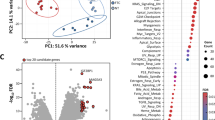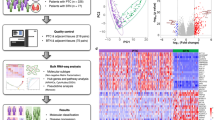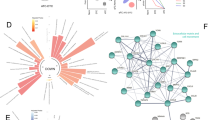Abstract
Conventional histology failed to classify part of non-medullary thyroid lesions as either benign or malignant. The group of tumours of uncertain malignancy (T-UM) concerns either atypical follicular adenomas or the recently called ‘tumours of uncertain malignant potential’. To refine this classification we analysed microarray data from 93 follicular thyroid tumours: 10 T-UM, 3 follicular carcinomas, 13 papillary thyroid carcinomas and 67 follicular adenomas, compared to 73 control thyroid tissue samples. The diagnosis potential of 16 selected genes was validated by real-time quantitative RT–PCR on 6 additional T-UM. The gene expression profiles in several groups were examined with reference to the mutational status of the RET/PTC, BRAF and RAS genes. A pathological score (histological and immunohistochemical) was estimate for each of the T-UM involved in the study. The correlation between the T-UM gene profiles and the pathological score allowed a separation of the samples in two groups of benign or malignant tumours. Our analysis confirms the heterogeneity of T-UM and highlighted the molecular similarities between some cases and true carcinomas. We demonstrated the ability of few marker genes to serve as diagnosis tools and the need of a T-UM pathological scoring.
This is a preview of subscription content, access via your institution
Access options
Subscribe to this journal
Receive 50 print issues and online access
$259.00 per year
only $5.18 per issue
Buy this article
- Purchase on Springer Link
- Instant access to full article PDF
Prices may be subject to local taxes which are calculated during checkout






Similar content being viewed by others
References
Al-Shahrour F, Diaz-Uriarte R, Dopazo J . (2004). FatiGO: a web tool for finding significant associations of Gene Ontology terms with groups of genes. Bioinformatics 20: 578–580.
Baris O, Mirebeau-Prunier D, Savagner F, Rodien P, Ballester B, Loriod B et al. (2005). Gene profiling reveals specific oncogenic mechanisms and signaling pathways in oncocytic and papillary thyroid carcinoma. Oncogene 24: 4155–4161.
Baris O, Savagner F, Nasser V, Loriod B, Granjeaud S, Guyetant S et al. (2004). Transcriptional profiling reveals coordinated up-regulation of oxidative metabolism genes in thyroid oncocytic tumors. J Clin Endocrinol Metab 89: 994–1005.
Benjamini Y, Hochberg Y . (1995). Controlling the false discovery rate: a practical and powerful approach to multiple testing. JRSSB 57: 289–300.
Bertucci F, Viens P, Hingamp P, Nasser V, Houlgatte R, Birnbaum D . (2003). Breast cancer revisited using DNA array-based gene expression profiling. Int J Cancer 103: 565–571.
De la Torre NG, Buley I, Wass JA, Turner HE . (2006). Angiogenesis and lymphangiogenesis in thyroid proliferative lesions: relationship to type and tumour behaviour. Endocr Relat Cancer 13: 931–944.
De Micco C, Vassko V, Henry JF . (1999). The value of thyroid peroxidase immunohistochemistry for preoperative fine-needle aspiration diagnosis of the follicular variant of papillary thyroid cancer. Surgery 126: 1200–1204.
Di Cristofaro J, Marcy M, Vasko V, Sebag F, Fakhry N, Wynford-Thomas D et al. (2006). Molecular genetic study comparing follicular variant versus classic papillary thyroid carcinomas: association of N-ras mutation in codon 61 with follicular variant. Hum Pathol 37: 824–830.
Durick K, Wu RY, Gill GN, Taylor SS . (1996). Mitogenic signaling by Ret/ptc2 requires association with enigma via a LIM domain. J Biol Chem 271: 12691–12694.
Du Villard JA, Wicker R, Crespo P, Russo D, Filetti S, Gutkind JS et al. (2000). Role of the cAMP and MAPK pathways in the transformation of mouse 3T3 fibroblasts by a TSHR gene constitutively activated by point mutation. Oncogene 19: 4896–4905.
Edgar R, Domrachev M, Lash AE . (2002). Gene Expression Omnibus: NCBI gene expression and hybridization array data repository. Nucleic Acids Res 30: 207–210.
Eisen MB, Spellman PT, Brown PO, Botstein D . (1998). Cluster analysis and display of genome-wide expression patterns. Proc Natl Acad Sci USA 95: 14863–14868.
Eszlinger M, Wiench M, Jarzab B, Krohn K, Beck M, Lauter J et al. (2006). Meta- and reanalysis of gene expression profiles of hot and cold thyroid nodules and papillary thyroid carcinoma for gene groups. J Clin Endocrinol Metab 91: 1934–1942.
Finley DJ, Zhu B, Barden CB, Fahey III TJ . (2004). Discrimination of benign and malignant thyroid nodules by molecular profiling. Ann Surg 240: 425–436.
Finn SP, Smyth P, Cahill S, Streck C, O'regan EM, Flavin R et al. (2007). Expression microarray analysis of papillary thyroid carcinoma and benign thyroid tissue: emphasis on the follicular variant and potential markers of malignancy. Virchows Arch 450: 249–260.
Franc B, de la Salmoniere P, Lange F, Hoang C, Louvel A, de Roquancourt A et al. (2003). Interobserver and intraobserver reproducibility in the histopathology of follicular thyroid carcinoma. Hum Pathol 34: 1092–1100.
Ge Y, Dudoit S, Speed TP . (2003). Resampling-based multiple testing for microarray data hypothesis. Test 12: 1–44.
Gentleman RC, Carey VJ, Bates DM, Bolstad B, Dettling M, Dudoit S et al. (2004). Bioconductor: open software development for computational biology and bioinformatics. Genome Biol 5: R80.
Giordano TJ, Kuick R, Thomas DG, Misek DE, Vinco M, Sanders D et al. (2005). Molecular classification of papillary thyroid carcinoma: distinct BRAF, RAS, and RET/PTC mutation-specific gene expression profiles discovered by DNA microarray analysis. Oncogene 24: 6646–6656.
Lloyd RV, Erickson LA, Casey MB, Lam KY, Lohse CM, Asa SL et al. (2004). Observer variation in the diagnosis of follicular variant of papillary thyroid carcinoma. Am J Surg Pathol 28: 1336–1340.
Hirokawa M, Carney JA, Goellner JR, DeLellis RA, Heffess CS, Katoh R et al. (2002). Observer variation of encapsulated follicular lesions of the thyroid gland. Am J Surg Pathol. 26: 1508–1514.
Hoffmann S, Maschuw K, Hassan I, Wunderlich A, Lingelbach S, Ramaswamy A et al. (2006). Functional thyrotropin receptor attenuates malignant phenotype of follicular thyroid cancer cells. Endocrine 30: 129–138.
Huang Y, Prasad M, Lemon WJ, Hampel H, Wright FA, Kornacker K et al. (2001). Gene expression in papillary thyroid carcinoma reveals highly consistent profiles. Proc Natl Acad Sci USA 98: 15044–15049.
Jarzab B, Wiench M, Fujarewicz K, Simek K, Jarzab M, Oczko-Wojciechowska M et al. (2005). Gene expression profile of papillary thyroid cancer: sources of variability and diagnostic implications. Cancer Res 65: 1587–1597.
Kononen J, Bubendorf L, Kallioniemi A, Barlund M, Schraml P, Leighton S et al. (1998). Tissue microarrays for high-throughput molecular profiling of tumor specimens. Nat Med 4: 844–847.
Lacroix L, Lazar V, Michiels S, Ripoche H, Dessen P, Talbot M et al. (2005). Follicular thyroid tumors with the PAX8-PPARgamma1 rearrangement display characteristic genetic alterations. Am J Pathol 167: 223–231.
Lubitz CC, Gallagher LA, Finley DJ, Zhu B, Fahey III TJ . (2005). Molecular analysis of minimally invasive follicular carcinomas by gene profiling. Surgery 138: 1042–1048.
Mazzanti C, Zeiger MA, Costouros NG, Umbricht C, Westra WH, Smith D et al. (2004). Using gene expression profiling to differentiate benign versus malignant thyroid tumors. Cancer Res 64: 2898–2903.
Mirebeau-Prunier D, Guyetant S, Rodien P, Franc B, Baris O, Rohmer V et al. (2004). Decreased expression of thyrotropin receptor gene suggests a high-risk subgroup for oncocytic adenoma. Eur J Endocrinol 150: 269–276.
More E, Fellner T, Doppelmayr H, Hauser-Kronberger C, Dandachi N, Obrist P et al. (2003). Activation of the MAP kinase pathway induces chicken ovalbumin upstream promoter-transcription factor II (COUP-TFII) expression in human breast cancer cell lines. J Endocrinol 176: 83–94.
Nikiforova MN, Biddinger PW, Caudill CM, Kroll TG, Nikiforov YE . (2002). PAX8-PPARgamma rearrangement in thyroid tumors: RT–PCR and immunohistochemical analyses. Am J Surg Pathol 26: 1016–1023.
Rhoden KJ, Unger K, Salvatore G, Yilmaz Y, Vovk V, Chiappetta G et al. (2003). RET/papillary thyroid cancer rearrangement in nonneoplastic thyrocytes: follicular cells of Hashimoto's thyroiditis share low-level recombination events with a subset of papillary carcinoma. J Clin Endocrinol Metab 91: 2414–2423.
Takahashi M, Yang XJ, Sugimura J, Backdahl J, Tretiakova M, Qian CN et al. (2003). Molecular subclassification of kidney tumors and the discovery of new diagnostic markers. Oncogene 22: 6810–6818.
Williams ED . (2000). Guest editorial: two proposals regarding the terminology of thyroid tumors. Int J Surg Pathol 8: 181–183.
Yang YH, Dudoit S, Luu P, Lin DM, Peng V, Ngai J et al. (2002). Normalization for cDNA microarray data: a robust composite method addressing single and multiple slide systematic variation. Nucleic Acids Res 30: e15.
Acknowledgements
We thank Marielle Mello, Dominique Couturier and Anne Coutoleau for technical help and data processing. We thank Kanaya Malkani for the critical reading of this paper. This work was supported by grants from the French Ministry of Research, the French National Institute for Medical Research (INSERM), the University Hospital of Angers and the University of Angers (PHRC 03-10).
Author information
Authors and Affiliations
Corresponding author
Additional information
Supplementary Information accompanies the paper on the Oncogene website (http://www.nature.com/onc).
Rights and permissions
About this article
Cite this article
Fontaine, JF., Mirebeau-Prunier, D., Franc, B. et al. Microarray analysis refines classification of non-medullary thyroid tumours of uncertain malignancy. Oncogene 27, 2228–2236 (2008). https://doi.org/10.1038/sj.onc.1210853
Received:
Revised:
Accepted:
Published:
Issue Date:
DOI: https://doi.org/10.1038/sj.onc.1210853
Keywords
This article is cited by
-
REGγ is associated with multiple oncogenic pathways in human cancers
BMC Cancer (2012)
-
QiSampler: evaluation of scoring schemes for high-throughput datasets using a repetitive sampling strategy on gold standards
BMC Research Notes (2011)
-
Death-associated protein 3 is overexpressed in human thyroid oncocytic tumours
British Journal of Cancer (2009)



